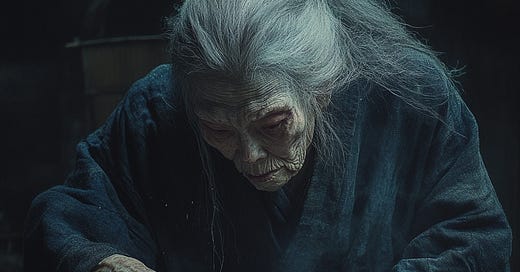Myth of the Day: Azukibabaa
In Japan's eerie countryside, an old hag washes adzuki beans, luring victims into dark forests, transforming souls into beans, and evading salt barriers.
Region/Culture: Japan, Asia
Mythos: Japanese Mythology (including Shinto and Yokai traditions)
Primary Type/Nature: Monsters and Beasts
Mythical Attributes: An old woman Yokai who makes the sound of adzuki beans being washed.
Role in Mythos: The Azukibabaa is known for washing red adzuki beans and is thought to be connected to Azukiarai, another bean-washing monster.
Relation to Humans: The Azukibabaa is generally considered a malevolent creature, luring humans with the sound of adzuki beans. Some theories suggest that the creature represents local legends about “Azuma-gama,” or red bean washing.
In the moonlit, misty landscapes of rural Japan, where rice fields stretch toward dark forests, there exists a creature as curious as she is chilling. Her name is Azukibabaa, and if you listen carefully, you might hear the haunting rustle of adzuki beans being washed by her withered hands.
Azukibabaa, whose name roughly translates to ‘Old Bean Woman,’ is an old hag-like figure shrouded in rags. Her eyes are but tiny slits that gleam ominously in the dark. Her mouth, hidden beneath layers of age and wrinkles, is just a disquieting smile. Her hands are gnarled and cracked from years of washing beans, a task she performs endlessly. Yet, don’t let her frail appearance fool you. She has the agility and strength that could rival a creature half her apparent age.
Her mythos finds its roots in the rich tapestry of Japanese mythology, particularly the traditions of Shinto and Yokai. She is a close relative, in spirit and craft, to Azukiarai—a beast also known for washing red adzuki beans. Both are lumped into the broad category of Yokai, which are supernatural creatures or spirits in Japanese folklore. The washing of adzuki beans is not merely a pastime but an aural trap that emanates through the thin Japanese air, across rivers and valleys, to the ears of unsuspecting humans.
You might wonder why washing beans would be considered malevolent. The sound, you see, is an irresistible lure. Those who follow it are led deeper into the forests or towards murky rivers, and not all of them return. It is said that the creature embodies the local legends of “Azuma-gama,” or the lore of red bean washing, a cautionary tale told to children who might wander too far into the misty wilderness.
Ah, but our Azukibabaa is not merely a sinister washerwoman. She has powers that extend beyond the allure of her beans. She’s known to have the ability to blend into her surroundings, a skill that allows her to watch her prey with an unnerving stillness. Once she captures her human victims, it’s believed she has the power to transform their spirits into more adzuki beans, adding them to her never-ending washing cycle. It’s an unsettling form of alchemy that dooms the lost souls to an eternal loop of being washed but never cleansed.
As for weaknesses, those are far fewer. It’s said that she avoids eye contact and would vanish if someone managed to look directly into her eyes. Also, she cannot cross purified salt lines, a common deterrent used in Shinto to keep away evil spirits. The purity of the salt, contrasting sharply with her malevolent nature, forms a barrier she can’t pass.
So, if you ever find yourself wandering the beautiful yet eerie landscapes of rural Japan and hear the unmistakable sound of adzuki beans being washed, remember the tale of the Azukibabaa. It might serve you well to carry a bag of purified salt and to avoid making eye contact. But above all, remember that some stories are told for a reason, and some sounds are better left unfollowed.
Suggested Further Reading
The Book of Yokai: Mysterious Creatures of Japanese Folklore by Michael Dylan Foster
Tales of Japan: Traditional Stories of Monsters and Magic by Chronicle Books
Explore more myths and wonders by visiting godsandmonsters.info.
Enjoy mythic tales on the move with our podcast, Five Minute Mythology.





